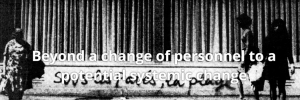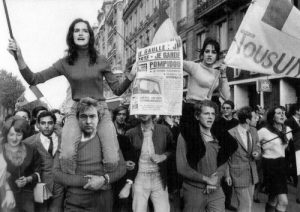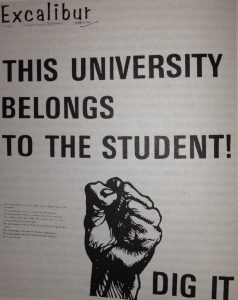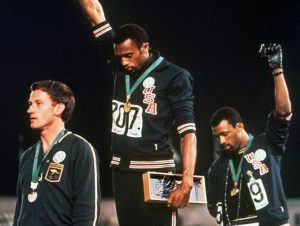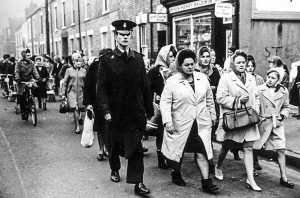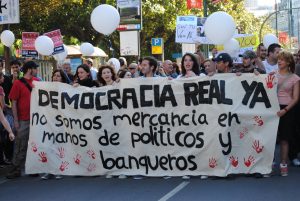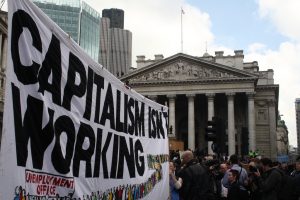
Lessons of 1968 for building counter-power today.
By Dr. Hilary Wainwright / 05.05.2018
Department of Peace Studies, Adjunct
University of Bradford
1968 was a historic year, but not in the sense of a unique moment in a linear march of history. The experiences of that year – and significantly, the years that preceded and followed – shaped a generation but produced ways of thinking that, in retrospect, have turned out to be both ambivalent and complex.
They shaped both Richard Branson – capitalist adventurer and self-publicist – and Tariq Ali – cultural and political rebel of notable flair and self-confidence. The international rebellions of these years laid the conditions for the women’s liberation movement of the 1970s, politicized grassroots workers’ organizations and converged ‘single issue’ campaigns to address systemic issues – such as military power, capitalism, imperialism and the nature of the state. But it also prepared the way for a renewal for capitalism – creating a new spirit of capitalism as flexible, innovative, decentralized and unregulated.
In this essay, I take a critical account of these ambiguities and their implications for different directions for a contested transition beyond the post-war settlement, while focusing on the specific possible legacies for a democratic, egalitarian dynamic of change. This must build on but go beyond social-democratic capitalism.
The political legacies of generational changes usually take the form of a circulation of elites a renewal of the personnel, the young coming to the rescue of the exhausted old. But once in a while, when it is the institutions that are exhausted or have become dysfunctional for the majority of the population, generational change can produce competing cultures – sometimes leading to competing strategies – for modernization of an institutional or even a whole political and economic system. These are circumstances in which the old institutions have lost credibility with a whole generation, who draw, in different ways, on the cultural innovations of the era to fashion their own alternatives.
By the late 1960s, the institutions of US-dominated but nation-state-based finance was beginning to crack. In workplaces across Europe, employers faced increasingly uncontainable pressures due to policies of full employment and with them enhanced bargaining power and a collective, self-confident workforce that was already restless with the Fordist deal of total obedience in exchange for high wages.
This began to affect profits and consequently to lead employers to build up political pressure for wage restraint and laws to curb the power of organized labour. In the UK, it was a Labour government that tried to implement these policies in 1967, in the face of strong resistance. At the same time the expansion of higher education had led to growing demands for expanded services, more diversity and greater power for students and teachers.
The demand for increased wages or investment clashed directly with the government imperatives to curb public spending, beyond the military. But these movements challenged not just constraints on public spending or the levels of profit, but went much deeper too.
The women’s liberation movement, for example, which emerged in 1969 and the early 1970s, upset fundamental social relations, challenging important cultural and material pillars of the established order. Notably, the women’s liberation movement upset the idealized framework of the nuclear family, dominated by the male breadwinner and serviced by the dependent woman, bringing up children in the isolation of her home.
This women’s movement did not come from nowhere or from some essential moral female force. Feminist historian, Sheila Rowbotham, is very clear that, ‘many of the ideas and underlying assumptions which were taken for granted in the early days of Women’s Liberation derived from the left movements and culture of the time’. She continues, more specifically, that ‘while we knew feminists might have wanted to distance ourselves from the r-r-revolutionary bombast which wafted around 1968, nevertheless we carried bits of that extraordinary year with us including its heady utopianism’.
It was its sense of possibility, and the strength of a shared determination and confidence to realize these aspirations that was the source of the distinctive, palpable, embodied and inextinguishable energy of ’68 – summed up in the famous graffiti on the walls of Paris and later on posters: ‘beneath the pavements, the beach’ and ‘Be realistic: demand the impossible’.
This sense of possibility infused many movements. Sheila Rowbotham describes how ‘we accommodated without difficulty to the emphasis on human agency characteristic of the sixties libertarian left and duly transported it into the Women’s Liberation groups which began to form during 1969’.
On the international front, movements for anti-colonial liberation and, as in Mexico, against authoritarian governments, spread like wildfire, making the legitimacy of old and not-so-old imperial and dictatorial orders to distinctly shaky. It inspired the would-be citizens of Czechoslovakia and Poland to revolt, further defining the revolts of 1968 as opening the search for a truly democratic alternative to both Soviet bureaucracy and market capitalism. This meant politically and economically democratic; not just ‘the command economy plus parliament’, as former Labour Minister Jack Straw once described his vision of socialism in 1968.
This combination of revolt from below and crises in the institutions of domination produced competing visions and different strategies for modernization. On the one hand, there were the rebellions of a self-confident youth who rejected the paternalism of the welfare state and state-defined socialism. They advocated and initiated directly participatory alternatives, including university courses, squats, communes and cooperative housing, centres for battered women, women-centred health care in the National Health Service (NHS) (well-woman clinics), community-controlled nurseries and a variety of forms of alternative media.
These alternatives were more in practice than in theory – hence their unfinished, experimental character. At the risk of making it sound more systematic and complete than it in fact was, I would argue that in retrospect, these were the scattered seeds of what had the potential to become a democracy-driven process of change in, against, and beyond the post-war settlement.
On the other hand, 1968 also prompted an alternative strategy, led by political parties and governments, advocating from the mid-1970s for an explicitly ‘market-led’ modernization. Margaret Thatcher and her entourage of free-market think-tanks had, for example, already begun their rise to power in the Conservative Party by the mid-70s following the defeat of Edward Heath and the growing power of the left in the Labour Party.
Competing visions of a transition
‘Modernisation’ from the early 1960s, that is, change to overcome the evident limits of the post-war welfare state and Keynesian macro-economic management, is often discussed, particularly by academics and journalists close to New Labour and especially in relation to public institutions, as a matter of technical, neutral necessity. By the 1980s, its dominant form advocated for marketization and privatization of public institutions, understood as, almost by definition, inherently ‘old’, as if internally unreformable.
In the hands of Margaret Thatcher, the vanguard politician of marketization, it also involved the release of ‘the entrepreneurial spirit’ – closely associated with individual freedom as the vital force for change. The idea of market-led politics as the only way – indeed, almost a synonym for modernization – became the dominant orthodoxy.
It came on the back of the defeat, marginalization and at times straightforward repression of an alternative, nascent democracy-driven process of change. This proposed renewal of institutions, not through profit-based incentives, but through the collaborative creativity of previously subordinate people – frontline public-sector workers, service users, manual workers, precarious presently isolated workers, ethnic minorities, single-parent families and so on.
Where market-led change meant privatization, democracy-driven change meant various forms of popular participation in public administration – here the key idea was participatory democracy – a central slogan in 1968 and clearly advocated for in, for example, the Port Huron statement of the US students’ movement, the SDS – Students for a Democratic Society. Participation of frontline workers and service users – those with the practical knowledge to guide services to be efficient in terms of maximising public value rather than profit – would be essential to this process.
To understand why these alternative directions of systemic change emerged, we need to explore the features of 1968 – and the years building up to it – that contain these ambivalent possibilities.
The rebellions of ’68 and the following decade were about a lot more than protest and exercising counter-power to the established order. For while counter-power implies an exercise of power within a given set of power relations – another way of describing militant bargaining power – the movements of the late 1960s and early 1970s challenged the very bases of dominant forms of power. They sort to transform and even eliminate power inequalities altogether.
Through their organized practice and their reflections on it, they overturned the fundamental assumptions of social democratic and liberal public policy. Specifically: first, understandings of knowledge (as primarily codified, scientific laws that can be centralized and through neutral experts become the basis of more or less benevolent state intervention and administration, based on the presumption to know people’s needs and to deliver social provisions in a standardized hierarchical manner).
The opening challenge came from students questioning their experiences of an increasingly standardized education. Angelo Quattrochi, an Italian activist journalist observing the events of Paris in May ’68, describes how ‘their minds are policed by discipline, patrolled by examinations. Their hearts frozen by authority. Their university mimes society, mimes the factory. And yet, they do not own and they do not belong’.
He goes on to summarize their attempts to overthrow the disciplines of the university (some refused to take exams, for example), and to question what kinds of knowledge were considered valid. In the late 1960s higher education encouraged the expectation that opportunities would increase for everyone to live a fuller life.
The reality proved contradictory. And here women experienced further reality shocks beyond the limits of the Fordist job market. As Rowbotham observes: ‘The shock of motherhood in weary isolation would dash many hopes, while the apparent sexual freedom enjoyed by women who belonged to the in-between strata of the educated middle class would turn out to be complicated by under-tows of double moral standards, fear and contempt’.
Women’s refusal to accept their isolation and simultaneously of their shared subordination inspired a further challenge to the dominant mentalities of the time, frozen as they were in the ideology and institutions of the Cold War. I’m thinking here of the dominant understandings of the individual, as atomized and separated from each other, and the collective as above the individual, solid and thing-like, as if social relations between individuals were of no significance.
This approach contributed to a way of thinking about society shaped by both a reaction to the bureaucratic collectivisms of Labour and the Soviet Union, and at the same time a revulsion at the hyped-up individualism of the consumer boom. Its implicit ‘relational’ view of society assumed relatively enduring but transformable relations between individuals, rather than either as the sum of individual action (the dogmatic individualism of free-market capitalism) or as supra-individual wholes (the bureaucratic collectivism of actually existing socialism) .
Extending gloved hands skyward, U.S. athletes Tommie Smith, center, and John Carlos stare downward during the playing of the Star Spangled Banner at the Summer Olympic Games in Mexico City on Oct. 16, 1968. (AP Photo)
The final challenge was to the definitions of universal rights as based on the male white paradigm and presumed to be universal. Here a decisive influence was movements like Civil Rights in the USA, followed by Black Power, which contributed to a new political language which defied cultural subordination. This was symbolized by the raised black-gloved fists of gold and bronze medallists Tommy Smith and John Carlos at the 1968 Olympics, as they stood on the podium to face the flag through the US national anthem. In his autobiography, Silent Gesture, Smith stated that the gesture was not a ‘Black power’ but a ‘human rights salute’. Certainly, that was how it was interpreted by oppressed and subordinated people across the world.
In general, on the ‘new’ left influenced by the social movements, these foundations underpinned a move away from the market–state binaries of the Cold War, in which the central strategic goal was to ‘seize’ state power or ‘win’ governmental power and take the reins of state to drive towards changing society, towards direct involvement in creating exemplary and feasible alternatives in civil society and the civil economy, facilitated or protected by a new kind of state. (Or, in terms that I explain in TNI’s 2016 State of Power report, a move from strategies based on ‘power as domination’ to those based on building power as transformative capacity for which power as domination can be a resource.)
This thinking, taking diverse forms according to specific historical contexts, influenced a rich and varied practice throughout the 1970s and into the 1980s, mixed in its outcome, but nonetheless important in its success and failure. Sometimes it involved a government dimension, combined with a partial vision of transforming the state, for example, the Greater London Council under Ken Livingstone in the 1980s, briefly Allende’s Chile in the late 1970s and the Brazilian Workers’ Party (PT) throughout the 1980s.
This sometimes took the form of a double track of building popular power at the same time as campaigning for electoral victory, but lacking a vision of transforming the state on the basis of popular power. Here the PT would again be a good example with its stress on participatory democracy – a key theme of the student movement in ’68 that influenced PT activists, many of whom were in exile in Paris in the late 1960s and 1970s. Also important was the PT’s understanding and valuing of the capacities of oppressed (articulated famously by PT member, Paolo Freire).
It also took the form of civil society organizations creating alternatives that exemplify participatory ways of organizing public services and campaign for privately owned workplaces to produce for social use, on the basis of social need and democratic control.
Across Europe throughout the 1970s, radical campaigns developed around housing, education, health, the needs of women and of people with disabilities that went way beyond protest and even counter-power but contributed to the creation of a counter-hegemony by showing that an alternative is possible and inspiring the confidence to work for it to be politically supported. (See the essay by Luciana Castellina for insights into the PCI and wider Italian experience.)
Crucial to these practices were close and innovative alliances with the organized labour movement and workers more generally. These were inspired initially by the French worker–student alliances, and some were more symbolic than strategic.
For example, at the University of Oxford, as students from the Sorbonne were joining Renault workers just outside Paris, we were going on our bikes and motor scooters, in our jumble-sale gaiety, to give out leaflets to car factory workers as they trudged to work in the dark at 6am. We were acting in solidarity with a political group whose members were being threatened with expulsion from the university for giving out leaflets to these same factory workers – who were facing pressures to increase productivity with no increase in wages.
The Headscarf Revolutionaries, led by Lillian Bilocca, marching on ship owners after a triple tragedy that devastated Hull’s fishing community in three weeks at the start of 1968.
In 1968, work and community came together when the wives of trawler men in Hull protested against the unsafe ships, which had resulted in the death of fishermen. At the time, such connections were rarely made, though 1968 was to open up new possibilities and also new platforms that enabled these grassroots initiatives to spread (the Hull women told their story to a packed gathering of the Institute for Workers’ Control, itself a convergence of radical students, artists and militant shop stewards).
As Rowbotham comments, ‘This protest from women who had previously had no public voice was profoundly inspirational’. Such experiences of the problems facing manual workers and the student radicalization this generated influenced more sustained and materially significant collaborations throughout the 1970s. Indeed, a frequent – though not by any means general – feature of the radical grassroots trade unionism of the period was the involvement of committed academics in helping to research employers’ strategies and facilitate workers’ development of alternatives.
Moreover, specific movements, notably the women’s movement and the more radical parts of the environmental movement, made organizing with appropriate groups of workers a priority. For example, students at Oxford supported the organization of college cleaners, following the example of feminists who played a sustained role during the early 1970s in the difficult night-to-night work of organizing night-shift cleaners in the offices of the City of London. Radical environmentalists worked closely with engineers and designers for the military company, Lucas Aerospace, on an inspiring trade union-led campaign to convert military production to socially useful products, including energy preservation and energy-friendly transport. These relationships had an autonomous political dynamic.
As relationships with working-class struggles was so important to 1968 movements – either in practice or in aspiration – the impact of the class war waged by neoliberal governments against both trade unions and the left-leaning governments, national and local, was devastating. Without the material, class alliances and base that these movements built up in the 1970s, the cultural break made by the rebellions of 1968 increasingly facilitated a shift towards the individualism of the market.
In the absence of these material sources of what I call ‘transformative power’, new understandings of knowledge could – and often did – underpin a turn to what has been called a ‘post-modern’ perspective which has tended to focus only on the cultural dimension of social movements as if, in its most extreme forms, an extra-discursive reality had no existence.
To give but one example, it could lead to an assumption that the treatment of women as sex objects was about culture alone – and therefore could be challenged without also resisting the economic super-exploitation and the social organization of reproduction through the nuclear family. A more materialist approach would explore the ways that these economic forms of oppression underpinned and enabled a contempt for women as human beings, without denying the importance of cultural representation – and its material consequences.
While it echoed and theorized the social movements’ concern with language in creating our social and cultural life rather than simply reflecting a reality ‘out there’ – those post-modernists who consider the symbolic or discursive to constitute reality cannot express what is central to social movements as political actors: their purposeful collective effort aimed at transforming structures that exist independently of their activities.
Post-modernism became much more influential with the rise of neoliberalism in the late 1970s. It proved attractive to a 1968 generation loyal to the culture of these movements but disillusioned with the frustrating efforts to bring about social change. It exercised its most significant influence, in France and in the UK, for example, where the early social movements had been strongest (in 1968 in France and early 1970s in the UK) and yet had suffered their severest defeat.
For a short but decisive period, it weakened the social movement left in the face of the neoliberal onslaught . It did so by a misleading polarization between so-called ‘new social movements’ and working-class organization, just at a time when these collaborations needed all the support they could muster, to be capable of developing any kind of counter-hegemonic challenge to the influence of free-market politics that was becoming increasingly influential from the late 1970 – the overthrow of Allende and the victory of Margaret Thatcher in 1979 and Ronald Reagan in 1981.
Transformation blocked, the market unleashed
A decisive factor in the appropriation of the spirit of ’68 by the right and insufficiency of the cultural break it had made, has been the blunt – and sometimes plain hostile – responses of mainstream parties of the left (and, in some cases, even trade unions) to the radical movements of the period. This occurred across Europe – in France, Germany and Italy it was especially notable in the response of Communist Parties in France and Italy, as well as social democracy.
In the UK it was exemplified by the Labour leadership’s sustained hostility towards the radical left influenced by ’68 – from the new politics of Tony Benn, who was explicitly responding to the new ideas of the late 1960s and trying to persuade the Labour Party to absorb these ideas into its political bloodstream (see his 1970s Fabian essay, A New Politics; Socialist Renaissance) through to an equally strong hostility to Ken Livingstone’s GLC, which could be described as ‘’68ers in office’ in the early 1980s and simultaneously to the 1984-85 miners’ strike, with its strong resonance among feminist, gay and black movements across the country, using the horizontal , non-hierarchical organizing principles associated with ‘new social movements’ , in its campaigning for twinning arrangements between local communities, usually led by women and the various groups that made up the urban left.
This hostility from the Labour Party was reinforced by the sometimes fierce repression by parties of the right and vicious attacks from the mainstream media. In general, this meant that these cultural breaks rarely found institutional expression, let alone drove institutional change.
Given this marginalization of the influence of 1968, it is in some ways surprising that like mountain streams, this radical thinking, vivid in its exemplary practice and with its powerful critique of fundamentally flawed institutions, bubbles to the surface, aided by memories, whenever these institutions hit crisis point again.
In particular, I’m thinking here of the wave of rebellions known as the ‘alter-globalization movement’, challenging the institutions of the corporate and neoliberal-led world order in the late 1990s. In their forms of organization, their anti-authoritarian culture and their anti-corporate, pro-participatory democracy they echoed the themes of 1968. And again, in the revolts of 2011, in the Indignados of Spain and the extraordinary surge of support for the reluctant leadership of Jeremy Corbyn in today’s Labour Party, we see it again.
Indignado demonstration: Real Democracy Now – We are not for sale by politicians and bankers
This time there is an echo of some of the more strategic understandings generated in 1968: Bertie Russell, an activist-academic involved in radical urban politics, born in 1985, makes the point:
‘In terms of a direct legacy of 1968, there’s a sense of history that I ought to feel but it isn’t necessarily there. But it remains an incredibly important reference point, not just for me but also for a lot of people I associate with. The story I tell myself – or some of us tell ourselves – is that this was a moving away from a workerist politics, organised around the site of liberation – or of struggle, or the place of opportunity for progressive politics – being defined by, on the one hand, the workplace, and, on the other hand, by the state.’
Focusing on Corbyn, for example, there’s been a break from the dominant, somewhat closed culture of the Labour Party’s recent past, including the traditional electorally focused nature of Party discussions. An opening up to a participatory culture, redolent of 1968, is most evident in the wide-ranging discussions at the festivals of The World Transformed, which for the last two years have been organized parallel to but in close interaction with the Labour Party Conference, with delegates moving freely between the two. It is supported by Momentum, the movement organized to consolidate and extend support for Corbyn’s leadership and a transformation of the Labour Party, but autonomous from it
‘There’s now a space’, says Bertie Russell, ‘How do we fill it? What is the opportunity to fill this space? This is when, suddenly, 1968 becomes relevant again, how do we think about new forms of community, where we organise society differently? Or new ways of thinking about economy. ’68 showed us there is an option other than focusing on the trade union as the place where anticapitalist struggle has to happen; or the state will be the thing that delivers change for you. Both of those things are upset by the spirit of 1968’.
This raises the question of how this bubbling up of participatory, direct-action politics, with a sense of feasible utopia, was possible. Of course, the disappearance and re-appearance of mountain streams is the subject of many a scientific, geological study. Similarly, the re-appearance of several features of the democratic, collaborative organizational culture of ’68 requires us to study how a culture of a new politics been kept alive and even renewed itself.
A decentralized infrastructure sustaining memory and continuity beneath the radar
In one sense 1968 is not wholly unique. There have been moments in the past that, while they were generated by previous developments, define a generation and produce teutonic shifts. The end of the Spanish Civil War in 1936 would be one example and the consolidation of Communist parties across most of Western Europe in 1945 would be another: in the UK, the people’s defeat of Nazi Germany on the frontline and on the home front produced a determination to defeat the enemies of pre-war peacetime – unemployment and poverty. And this in turn led both to the election of Labour’s modest Clem Attlee over heroic war leader Winston Churchill, and to laying the foundations of full (male) employment and levels of education and health care that shaped the self-confidence and optimism of the generation born as the war ended.
The radicalization shaped by these earlier moments led to the growth of political parties which then acted as a collective memory of the moment and at least some of its ideas: in 1936, it was the Communist Parties, especially of Southern Europe, and in the UK in 1945 was the Labour Party. After 1968, with the exceptional experience of Norway, it was unusual for a party of the left social movements to emerge.
In all moments of radicalization, people still keep alive their own particular beliefs in ways that go beyond formal institutions: sometimes simply through the strength of their conviction, through passing ideas on in their own families, through personal friendship networks and more or less organized friendship groups. To give one example, a group of Communist or ex-Communist Party members met in 1956 to try to understand what was going on in the world, especially the Communist world, and they’ve been meeting every month ever since until at least well into the life of the magazine that I co-founded in 1996, calling themselves the Anjou Club after the restaurant in which they first met, and inviting speakers from younger generations to help them keep up to date.
As the movements of the late 1960s and early 1970s faced dispersion and decline, relationships and informal networks, in the absence of significant political parties that opened themselves to the political generation of ’68, were of even greater importance, especially since the everyday working-class organizations were so dramatically weakened as neoliberal ideas evolved into policies aimed at destroying all material evidence of collectivism, let alone socialism.
What was distinctive in this regard about the aftermath of ’68 was that the culture of this moment of radicalization was one that valued and facilitated this recurring informal and personal process of building a shared memory. The result was consciously created initiatives for sharing ideas, cross-fertilizing across social groups and localities, communicating with a wider constituency and debating and clarifying ideas as well as creating means of cultural nourishment and mutual solidarity.
At least in the UK, throughout the 1970s most towns would have a local left bookshop; study, research and reading groups sprouted everywhere, in universities and independently; numerous radical theatre groups would tour pubs and clubs across the land, bringing activists from different generations together; alternative publications would come and go, leaving newly skilled communicators who would then start up or support new initiatives; sometimes young activists would engage with older institutions, for example, the city-wide Trade Union Councils, and encourage them to make new links, with women’s, campaigning tenants’ and community groups.
Sometimes local institutions would coalesce to bring these various initiatives together in a way that strengthened all and did not undermine the autonomy of any of them. Tyneside Socialist Centre and Islington Socialist Centre were two examples that had, for a few years, relatively stable structures; but in many localities, a disparate left converged periodically both to debate and discuss, and to pool their strengths in the face of the cuts or the factory closures that gathered pace as Keynesian counter-cyclical spending gave way to monetarism, an ‘acceptable level of unemployment’, a cutting back of state spending and a managed process of de-industrialization.
The distinctive character of the ’68 movements’ break from the centralized political models of the past in a sense meant that these movements were culturally prepared to make the most of these decentralized, plural means of achieving political continuity, reproducing a shared memory, learning lessons and interconnecting the parts.
The value the movements placed on practical knowledge, not against theoretical knowledge, but with its own distinct validity, tended to legitimize the idea of autonomous initiatives with their own viability; not dependent on the centre for their life blood.
On the other hand, the break from the authority of ‘expert’ knowledge was not – unlike the Lutheran break from religious authority – in favour of the individual conscience, but rather of collaborative autonomy. Thus the favoured model was decentralized but coordinated, which enabled ideas to spread and be reproduced without a nationally organized party.
Despite formal defeat then, a lot of initiative and capacity maintained itself beneath the conventional political radar. It was this that would revive itself and break through the radar when there was an opportunity for a collective effort to make a difference.
The ambivalent potential of the World Wide Web and digital technology – and its roots in the counter-culture of ’68
This combination of decentralized initiative with networked coordination is exactly what describes the social relations enabled by the web, the internet and the new digital technologies generally. One could argue that the counter-culture of ’68 prepared the way for the cyber-culture of the 21st century. There is, indeed, a direct historical continuity with the rebellions of the 1960s. The use of the internet and associated technologies as tools to fulfil a dream of harmonious living (with each other and with the environment) has roots, interestingly, in the Californian counter-culture of the late 1960s.
Whole Earth Catalog was the counter-culture bible of the 1960s, inspiring both Steve Jobs and movements such as Wikipedia
The continuity is not so much with the ideologically committed New Left politics of that era as with the more diffuse desire to change the world found in the ‘back to the land’ commune movement known as the ‘new communalism’. This was characterized by a holistic vision of personal and social development, and commitment to an ethic of sharing and spreading information and innovation – epitomized and propagated by the Whole Earth Catalog associated with the supreme counter-cultural networker and entrepreneur, Steward Brand.
Although some of the specific technologies go back to collaboration among technologists working on defence, the development of the internet was made possible by the miniaturization of computers that enabled individual users to have complete control over their machines. At the same time the Whole Earth Catalog and the cultural logic of the new communalism provided the computer scientists – most of whom emerged out of the intellectual and organizational legacy of Cold War research – with the uses, and therefore marketing frames, for the new personal machines.
Stewart Brand worked hard to bring these two groups together, along with radical geeks and the alternative lifestyle scene, although he later moved towards embracing Ecomodernism, which rather contradicts his earlier enthusiasm for grassroots creativity and collaboration.
The open, sharing ethic underlying the use of these new tools was immeasurably strengthened by the creation of the World Wide Web by Tim Berners-Lee and his colleagues at the European Organization for Nuclear Research (known by its French acronym, CERN). He was quite explicit about its importance as an open resource for a changing society – since when we have also seen the increasing monopolization led by digital giants such as Facebook and Google.
Whatever the exact history of the information and communication technology (ICT) revolution, we can see that it exhibits the same ambivalence as all the streams flowing in some way from’68: driven by a culture that favoured both collaboration and autonomy and which could be a tool either for renewing the private market or for spreading the cooperative economy.
A turning point as the unregulated market faces crisis
Ten years after the collapse of Lehmann Brothers in the USA (which precipitated the Great Recession) and in the year of the collapse of Carrillion in the UK, and probably several other major private contractors (very often involved in private finance initiatives (PFIs), or the so-called public–private partnerships, PPPs), we seem to be at a point where what is at stake is not just corporate greed and irresponsible lending, not just outsourcing, not just PFIs, but the whole doctrine of ‘the market knows best’, of the downsized state, of allowing only corporations to plan, of abandoning the boundary between the civil service and the private sector.
‘We are at a turning point’, comments Bertie Russell, continuing his reflections on ‘whatever the hell the spirit of 1968 is’, where ‘the bit that got taken was individual freedom, and that got stitched into the narrative of neoliberal management, but the demand was for a collective freedom. Now that is the point we’re at. The myth is busted, the individual freedom of neoliberalism is done – we have to re-stitch this story of us as collectives and us as communities. The idea is to self-define a collective freedom. It’s taken a long time to recover’.
Bertie’s right that Thatcher wrenched the desire for individual freedom from its context of social emancipation, and turned it into its emaciated, atomistic form to justify the unregulated market. But now, 50 years on since the Free Speech Movement in Berkeley, one of the iconic direct actions of 1968, here is a new generation which is taking it back and acting on the belief of one of this movement’s leaders, the late Mario Savo, who stressed individual responsibility in the context of a social movement for freedom. He said:
‘There’s a time when the operation of the machine becomes so odious, makes you so sick at heart, that you can’t take part. And you’ve got to put your bodies upon the gears and upon the wheels, upon all the apparatus and you’ve got to make it stop. And you’ve got to indicate to the people who run it, that unless you’re free, the machine will be prevented from working at all’.
This, after all, is what young people were doing when they travelled to Seattle in 1999 to close down the World Trade Organization (WTO) and stop the Multilateral Agreement on Investment; when, in 2011, they occupied Zucotti Park, Wall Street, and St Paul’s churchyard bordering the City of London; when in the same year they organized alternative communities of resistance in the squares of Spain and of Greece. And when they left home, abandoned jobs – if they had one – to volunteer for Bernie Sanders or Jeremy Corbyn and to build new political movements like Momentum in the UK and Our Revolution in the US that have already disrupted the political machines in both countries.
We may not be on the verge of new 1968, whatever that would mean (though you never can tell!) and the energies of these movements have only a tangential connection to their predecessor. But it’s always a source of strength to know that there have been precedents from which lessons can be learnt. It also helps to work with leaders who have themselves been part of those earlier movements and who therefore grasp the potential of the new generation and are responsive to its needs and aspirations.
Originally published by the Transnational Institute under a Creative Commons Attribution-Noncommercial-No Derivative Works 3.0 license.



